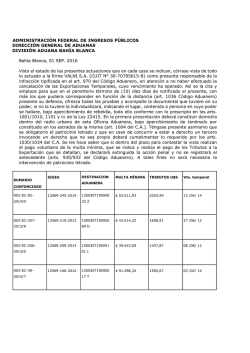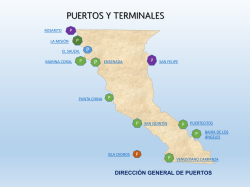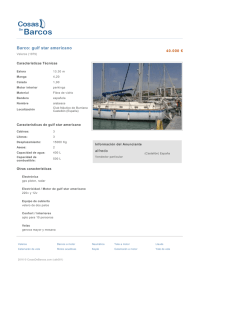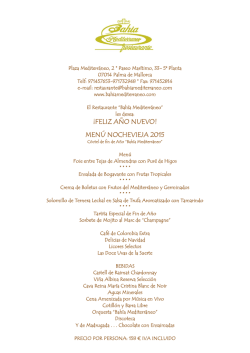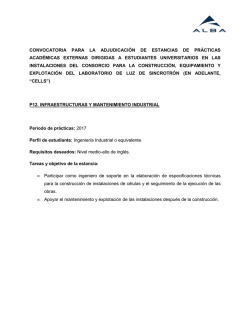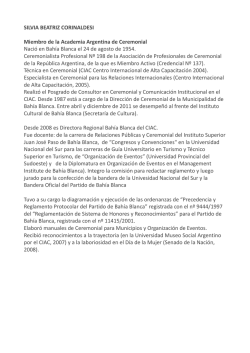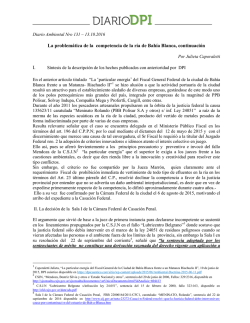
Blooms of Trichodesmium erythraeum and T. thiebautii
CICIMAR Oceánides 27(1): 61-64 (2012) NOTA BLOOMS OF Trichodesmium erythraeum AND T. thiebautii (CYANOBACTERIA, OSCILLATORIALES) IN THE BAHÍA DE LA PAZ, GULF OF CALIFORNIA Florecimientos de Trichodesmium erythraeum y T. thiebautii (Cyanobacteria, Oscillatoriales) en la Bahía de La Paz, Golfo de California RESUMEN. Se hicieron muestreos de siete florecimientos de Trichodesmium en la Bahía de La Paz entre 2005 y 2011. Trichodesmium erythraeum y T. thiebautii fueron las especies responsables; esta ultima especie es registrada por primera vez en el Golfo de California. Los florecimientos de T. erythraeum presentaron concentraciones entre 0.75 y 4.5 × 106 céls L–1 mientras que Trichodesmium thiebautii alcanzó densidades entre 1.86 y 2.34 × 106 céls L–1. Los florecimientos ocurrieron dentro de un intervalo de temperatura de 20 y 30 °C y no causaron ningún efecto negativo sobre la biota marina de la zona. Gárate-Lizárraga, I.1 & R. E. MuciñoMárquez2. 1Departamento de Plancton y Ecología Marina, CICIMAR-IPN. Apartado postal 592, La Paz, Baja California Sur, 23000, México. 2Laboratorio de Ficología, Universidad Autónoma Metropolitana, Unidad Xochimilco. Calzada del Hueso 1100, Col. Villa Quietud, México, D.F., 04960, México. email: [email protected] Gárate-Lizárraga, I. & R. E. Muciño-Márquez. 2012. Blooms of Trichodesmium erythraeum and T. thiebautii (Cyanobacteria, Oscillatoriales) in the Bahía de La Paz, Gulf of California. CICIMAR Oceánides, 27(1): 61-64. Microalgae blooms (also named “red tides”) are common seasonal events occurring throughout the littoral of the Baja California Peninsula (GárateLizárraga, 2011). Bahía de La Paz is a large bay where blooms have been sighted since 1984. More than 40 blooms and more than 25 bloom-forming taxa have been recorded, including the lagoon called the Ensenada de La Paz located in its southern-most extension (Gárate-Lizárraga et al., 2001; 2006). The most reported bloom-forming species at the southern end of the bay are dinoflagellates and diatoms, and the ciliate Myrionecta rubra (Lohmann, 1908) Jankowski, 1976. Other phytoplankton groups, such as raphidophytes, silicoflagellates, and cyanobacteria have been rarely reported (Band-Schmidt et al., 2005; Gárate-Lizárraga et al., 2006; 2009). Blooms of oscillatorial cyanobacteria are a potential source of toxins in the ciguatera food chain and have been previously reported to contain certain types of paralyzing toxins (Kerbrat et al., 2010). An important component of the phytoplankton community during blooms in tropical and subtropical seas are species of Trichodesmium Ehrenberg ex Gomont, 1892 Fecha de recepción: 14 de marzo de 2012 which comprise around 10 species of filamentous organisms that are mainly distributed in warm-temperate and tropical seas (Cronberg & Annadotter, 2006). Trichodesmium are ecologically important because they are non-heterocystous nitrogen-fixing species that contribute nitrogen in oligotrophic (Holl et al., 2007) and eutrophic waters (White et al., 2007). Blooms of Trichodesmium are rarely reported in the Gulf of California (Cortés-Altamirano, 1988) and particularly in the Bahía de La Paz (García-Pámanes & Gárate-Lizárraga, 1984; Ochoa et al., 1997; MuciñoMárquez, 2010). In this his study we describe recent blooms of Trichodesmium erytraeum Ehrenberg ex Gomont, 1892 and Trichodesmium thiebautii Gomont ex Gomont, 1892 in the Bahía de La Paz. Samples from six surface blooms were collected at different sites in the Bahía de La Paz (Fig. 1). Also, samples of a bloom detected in September 2006 were collected at three depths (0, 15, and 30 m). Sea surface temperature was measured with a bucket thermometer. In all cases, cell counts were made in a Sedgewick-Rafter chamber or in 5 and 25 mL sedimentation chambers under an inverted phase-contrast Zeiss microscope. Cells of each trichome were counted to estimate abundance of Trichodesmium species. A compound microscope (model CH2, Olympus, Japan) was used to measure cells. A digital Konus camera and SONY Cyber-shot camera (8.1 MP) were used to record images. The blooms of T. erythraeum and T. thiebautii were observed at different sites at the southern end of the Bahía de La Paz. The surface water color during the blooms varied from pale brown to pinkish red. A bloom detected on 10 December 2011 was yellow pale. Here, Trichodesmium cells were forming a single filament (Fig. 2) of more than 90 trichomes (Fig. 3). Surface blooms of T. erythraeum reached densities from 0.75–4.5 × 106 cells L–1 and T. thiebautii reached densities from 1.86–2.34 × 106 cells L–1 (Table 1). T. erythraeum had a well-marked vertical distribution on 25 June 2006. The highest concentrations occurred at the surface and the lowest at 30 m (Table 1). Blooms of Trichodesmium species occurred in a range of 20–30 °C. Trichodesmium specimens fit well within the diagnosis and descriptions of Desikachary (1959). Morphological differences between these two species seem to be related to the diameter:height ratio of cells in the trichome, higher in T. erythraeum than in T. thiebautii. The filaments of T. erythraeum are usually attenuated with a calyptra at the end; calyptrae are not found in T. thiebautii (Desikachary, 1959). Both species occur in solitary trichomes or in colonies of aggregated filaments. Trichodesmium can ocFecha de aceptación: 10 de abril de 2012 62 GÁRATE-LIZÁRRAGA & MUCIÑO-MÁRQUEZ Figure 1. Locations where blooms of Trichodesmium species were observed in the Bahía de La Paz, Gulf of California, between 2005 and 2011. cur as tufts formed by parallel arrays of filaments (T. erythraeum, Figs. 3–6) or radial puff arrays of filaments (T. thiebautii, Figs. 7 and 8). The latter species can form fusiform (Fig. 7) and puff aggregates (Fig. 8), according to Carpenter et al. (2004). Trichomes had approximately 6–80 cells. The T. erythraeum cells width is 7-15 µm and the cells length is 5-10 µm. T. thiebautii cells were not measured. Blooms of T. erythraeum have rarely been reported along the Pacific coast of Mexico (CortésAltamirano, 1988; Figueroa-Torres, 1994; GárateLizárraga & Siqueiros-Beltrones, 1998; White et al., 2007) and Mexican coast of the Gulf of Mexico (Aldeco et al., 2009; Aké-Castillo, 2011). Blooms of T. thiebautii have not been reported until now. This finding is a new record for this species that caused a bloom in Bahia de La Paz. Massive blooms of T. erythraeum were reported in the Ensenada de La Paz during 1981 (García-Pámanes & Gárate-Lizárraga, 1984). These blooms were attributed to municipal discharges into the shallow coastal lagoon. When discharges stopped, blooms of T. erythraeum were not observed for a long time. Although Trichodesmium blooms are a good Table 1. Data from seven locations during Trichodesmium blooms in the Bahía de La Paz. Bloom 1 2 3 4 5 6 7 Date 28/06/2005 29/06/2005 9/12/2006 25/09/2006 25/09/2006 25/09/2006 17/05/2009 12/05/2010 12/05/2010 12/05/2010 13/05/2010 13/05/2010 13/12/2010 14/12/2010 10/12/2011 10/12/2011 (Sample 1) (Sample 2) (Sample 1) (Sample at 0 m) (Sample at 15 m) (Sample at 30 m) (Sample 1) (Sample 1) (Sample 2) (Sample 3) (Sample 1) (Sample 2) (Sample 1) (Sample 2) (Sample 1) (Sample 2) Species T. erythraeum T. erythraeum T. erythraeum T. erythraeum T. erythraeum T. erythraeum T. erythraeum T. erythraeum T. erythraeum T. erythraeum T. erythraeum T. erythraeum T. thiebautii T. thiebautii T. erythraeum T. erythraeum Abundance (cells L-1) T °C 1.89 × 106 1.23 × 106 2.74 × 106 1.6 × 106 45.8 × 103 20.6 × 103 0.75 × 106 4.5 × 106 3.63 × 106 3.41 × 106 1.91 × 106 1.27 × 106 1.86 × 106 2.34 × 106 0.82 × 106 0.33 × 106 26.5 26 21 30 28 26.5 25.5 24 24 24 24.5 24.5 20 22 20 20 BLOOMS OF CYANOBACTERIA IN BAHÍA DE LA PAZ Figures 2–8. Solitary trichome of Trichodesmium erythraeum (Fig. 2). Different tufts of T. erythraeum blooms (Figs. 3, 4, 5, and 6), arrows indicate the calyptra at the end of the trichomes. Tuft (Fig. 7) and Puff (Fig. 8) colonies of T. thiebautii in the Bahía de La Paz. source of newly fixed carbon and nitrogen, they serve as a food source only for a selected group of copepods because others organisms are deterred by a toxin produced by these cyanobacteria (Hawser et al., 1992; Capone 1997). Occasionally, T. erythraeum and T. thiebautii have been implicated in die-offs and negatively affect public human health (Sato et al., 1963) and marine life (Landsberg, 2002). Toxicity of Trichodesmium has been recorded mainly in marine grazers (Hawser et al., 1992; Preston et al., 1998); public health records exist (Sato et al., 1963). Strains can produce neurotoxins and hepatotoxins (Hawser et al., 1991, 1992; Cronberg & Annadotter, 2006); Lipid-soluble toxins (CTXs-like toxins) and water-soluble paralyzing toxins were recently detected in T. erythraeum and T. thiebautii (Kerbrat et al., 2010), showing the contribution of these pelagic cyanobacteria to the ciguatera food chain. Blooms of T. erythraeum and T. thiebautii were found in small patches (10–30 m long and 3–16 m wide), which accumulated along the shore by wind forcing or during rising tides (Gárate-Lizárraga et al., 2006). They were observed for one or two days. These small blooms were not implicated in die-off events that cause negative effects to marine biota. To prevent future public health and aquaculture problems by these toxic species, a monitoring program in the Bahía de La Paz and other coastal areas of the State of Baja California Sur is an on-going activity. ACKNOWLEDGEMENTS The projects were funded by Instituto Politécnico Nacional (SIP-20110281, and SIP-20121153) and by CIBNOR (PC3.2). I.G.L. is a COFAA and EDI fellow. REMM was CONACYT (269167) and PIFI fellow. We also thank two anonymous referees for their helpful comments and suggestions. We thank María C. Ramírez-Jáuregui (ICMyL-UNAM, Mazatlán) for the literature search. REFERENCES Aké-Castillo J. A. 2011. Temporal dynamics of Trichodesmium erythraeum (Cyanophyta) in the National Park “Sistema Arrecifal Veracruzano” in the Gulf of Mexico. Jour. Environ. Biol., 32: 395-399. Aldeco, J., M.A. Monreal-Gómez, M. Signoret, D.A. Salas-de León, & D.U. Hernández-Becerril. 2009. Occurrence of a subsurface anticyclonic eddy, fronts, and Trichodesmium spp. over the Campeche Canyon region, Gulf of Mexico. Cienc. Mar., 35: 333–344. Band-Schmidt, C., A. Martínez-López, & I. GárateLizárraga. 2005. First record of Chattonella marina in Bahía de la Paz, Gulf of California. Harmful Algae News, Paris, 28: 6–7. 63 64 GÁRATE-LIZÁRRAGA & MUCIÑO-MÁRQUEZ Capone, D.G., J. Zehr, H. Paerl, B. Bergman & E.J. Carpenter. 1997. Trichodesmium: A globally significant marine cyanobacterium. Science, 276: 1221–1229. Carpenter, E.J., A. Subramanian & D.G. Capone. 2004. Biomass and primary productivity of the cyanobacterium Trichodesmium spp. in the southwestern tropical N Atlantic Ocean. Deep– Sea Res. 51: 173–203. Cortés-Altamirano, R. 1988. Abundancia de Oscillatoria erythraea (cianofita planctónica marina) en el litoral de Mazatlán, Sin., México. Rev. Lat. Microbiol., 30: 169–179. Cronberg, G. & H. Annadotter. 2006. Manual on aquatic cyanobacteria. A photo guide and a synopsis of their toxicology: Copenhagen, International Society for the Study of Harmful AlgaeUnited Nations Educational, Scientific and Cultural Organization. 106 p. Desikachary, T.V. 1959. Cyanophyta. I.C.A.R. Monographs, New Delhi. 686 p. Figueroa-Torres, M.G. 1994. Florecimiento de Trichodesmium erythraeum Ehr. Ex Gomont, en las lagunas Inferior y Oriental, Oaxaca. 15–21, In: Alvarez-Silva, C., M.G. Figueroa-Torres, A. Esquivel-Herrera & S. Gómez-Aguirre (Eds.). Serie Grandes Temas de la Hidrobiología: los sistemas litorales, UAM, UNAM. Gárate-Lizárraga, I. 2011. Harmful algae blooms along the coast of the Baja California Peninsula. Harmful Algae News, 44: 6–7. Gárate-Lizárraga, I. & D. Siqueiros-Beltrones. 1998. Time variation of phytoplankton assemblages in a subtropical lagoon system after the 1982-83 El Niño event. Pacific Science. 52: 79–97. Gárate-Lizárraga, I, M.L. Hernández-Orozco, C.J. Band-Schmidt & G. Serrano-Casillas. 2001. Red tides along the coasts of Baja California Sur, Mexico (1984 to 2001). Oceánides, 16(2).127134. Gárate-Lizárraga, I., M.S. Muñetón-Gómez & V. Maldonado-López. 2006. Florecimiento del dinoflagelado Gonyaulax polygramma frente a la Isla Espíritu Santo, Golfo de California México. Rev. Invest. Mar., 27: 31–39. Gárate-Lizárraga, I., C.J. Band-Schmidt, F. AguirreBahena & T. Grayeb-Del Alamo. 2009. A multispecies microalgae bloom in Bahía de La Paz, Gulf of California, México (June 2008). CICIMAR Oceánides. 24 (1): 15–29. García-Pámanes, J. & I. Gárate-Lizárraga. 1984. Importancia de los productores primarios (fitoplancton) en la Ensenada de La Paz. 1–8, In: Memoria de la Primera Reunión sobre Ciencia y Sociedad. Presente y futuro de la Ensenada de La Paz. La Paz, BCS, México. Hawser, S.P., G.A. Codd, D.G. Capone, & E.J. Carpenter. 1991. A neurotoxic factor associated with the bloom-forming cyanobacterium Trichodesmium. Toxicon, 29: 277–278. Hawser, S.P., J.M. O’Neil, M.R. Roman & G.A. Codd. 1992. Toxicity of blooms of the cyanobacterium Trichodesmium to zooplankton. J. App. Phycol., 4: 79–86. Holl, C.M., T.A. Villareal, C.D. Payne, T.D. Clayton, C. Hart & J. Montoya. 2007. Trichodesmium in the western Gulf of Mexico: 15 N2-fixation and natural abundance stable isotope evidence. Limnol. Oceanogr., 52: 2249–2259. Kerbrat, A.S., H.T. Darius, S. Pauillac, M. Chinain, D. Laurent, 2010. Detection of ciguatoxin-like and paralysing toxins in Trichodesmium spp. from New Caledonia lagoon. Mar. Pollut. Bull., 61: 360–366. Landsberg, J.H., 2002. The effects of harmful algal blooms on aquatic organisms. Rev. Fish. Sci., 10: 113–390. Muciño-Márquez, R.E. 2010. Variación estacional de la comunidad fitoplanctónica en granjas de atuneras en la Bahía de La Paz B.C.S. Tesis de Maestría. CICIMAR-IPN, La Paz, BCS, México. 105 pp. Ochoa, J.L., A. Sánchez-Paz, A. Cruz-Villacorta, E.J. Núñez-Vázquez & A. Sierra-Beltrán. 1997. Toxic events in the North Pacific Coastline in Mexico during 1992-1995: origin and impact. Hydrobiologia, 352: 195–200. Preston, N.P., M.A. Burford & D.J. Stenzel. 1998. Effects of Trichodesmium spp. blooms in peneid prawn larvae. Mar. Biol., 131: 671–679. Sato, S., M.N. Paranangua & E. Eskinazi. 1963. On the mechanism of red tide of Trichodesmium in Recife north eastern Brazil, with some considerations of the relation to human disease Tamandare fever. Trab. Inst. Oceanogr. Univ. Fed. Pernambuco Recife, 5/6: 7–50. White, A.E., F.G. Prahl, R.M. Letelier, & B.N. Popp. 2007. Summer surface waters in the Gulf of California: Prime habitat for biological N2 fixation. Global Biogeochem. Cycles, 21: 1-11.
© Copyright 2025
